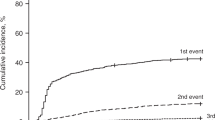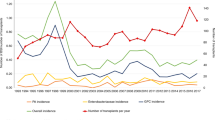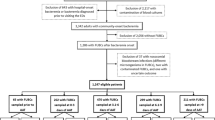Summary:
Vancomycin-resistant enterococcal (VRE) infection is a growing threat. We studied the incidence, risk factors, and clinical course of early-onset VRE bacteremia in allogeneic hematopoietic stem cell transplant recipients. We carried out a chart review of 281 allogeneic hematopoietic stem cell transplant recipients from 1997–2003, including preparative regimen, diagnosis, status of disease, graft-versus-host disease prophylaxis, antimicrobial therapy, and survival. VRE bacteremia developed in 12/281 (4.3%) recipients; 10 (3.6%) were within 21 days of transplant. Diagnoses were acute leukemia (7), NHL (2), and MDS (1). In all, 70% had refractory/relapsed disease; 30% were in remission. In total, 50% had circulating blasts. Nine of 10 had matched unrelated donors (7/9 with CD8+ T-cell depletion). The average time to positive VRE cultures was 15 days; average WBC was 0.05, and 80% had concomitant infections. Despite treatment, all patients died within 73 days of VRE bacteremia. Intra-abdominal complications were common. Causes of death included bacterial or fungal infection, multiorgan failure, VOD, ARDS, and relapse. A total of 60% of patients engrafted neutrophils, but none engrafted platelets. Early VRE bacteremia after allogeneic bone marrow transplant is associated with a rapidly deteriorating clinical course, although not always directly due to VRE. Early VRE may be a marker for the critical condition of these high-risk patients at the time of transplant.
This is a preview of subscription content, access via your institution
Access options
Subscribe to this journal
Receive 12 print issues and online access
$259.00 per year
only $21.58 per issue
Buy this article
- Purchase on Springer Link
- Instant access to full article PDF
Prices may be subject to local taxes which are calculated during checkout
Similar content being viewed by others
References
Zinner SH . Changing epidemiology of infections in patients with neutropenia and cancer: emphasis on Gram-positive and resistant bacteria. Clin Infect Dis 1999; 29: 490–494.
Shlaes DM, Binczewski B, Rice LB . Emerging antimicrobial resistance and the immunocompromised host. Clin Infect Dis 1993; 17 (Suppl 2): S527–S536.
Frere P, Hermanne JP, Debouge MH et al. Changing pattern of bacterial susceptibility to antibiotics in hematopoietic stem cell transplant recipients. Bone Marrow Transplant 2002; 29: 589–594.
Morris Jr JG, Shay DK, Hebden JN et al. Enterococci resistant to multiple antimicrobial agents, including vancomycin. Establishment of endemicity in a university medical center. Ann Intern Med 1995; 123: 250–259.
Edmond MB, Ober JF, Weinbaum DL et al. Vancomycin-resistant Enterococcus faecium bacteremia: risk factors for infection. Clin Infect Dis 1995; 20: 1126–1133.
Kapur D, Dorsky D, Feingold JM et al. Incidence and outcome of vancomycin-resistant enterococcal bacteremia following autologous peripheral blood stem cell transplantation. Bone Marrow Transplant 2000; 25: 147–152.
Peetermans WE, Sebens FW, Guiot HF . Vancomycin-resistant Enterococcus faecalis in a bone-marrow transplant recipient. Scand J Infect Dis 1991; 23: 105–109.
Koc Y, Snydman DR, Schenkein DS, Miller KB . Vancomycin-resistant enterococcal infections in bone marrow transplant recipients. Bone Marrow Transplant 1998; 22: 207–209.
Kirkpatrick BD, Harrington SM, Smith D et al. An outbreak of vancomycin-dependent Enterococcus faecium in a bone marrow transplant unit. Clin Infect Dis 1999; 29: 1268–1273.
McNeil SA, Clark NM, Chandrasekar PH, Kauffman CA . Successful treatment of vancomycin-resistant Enterococcus faecium bacteremia with linezolid after failure of treatment with synercid (quinupristin/dalfopristin). Clin Infect Dis 2000; 30: 403–404.
Hachem R, Afif C, Gokaslan Z, Raad I . Successful treatment of vancomycin-resistant Enterococcus meningitis with linezolid. Eur J Clin Microbiol Infect Dis 2001; 20: 432–434.
Hachem RY, Hicks K, Huen A, Raad I . Myelosuppression and serotonin syndrome associated with concurrent use of linezolid and selective serotonin reuptake inhibitors in bone marrow transplant recipients. Clin Infect Dis 2003; 37: e8–e11.
Manzella JP . Quinupristin-dalfopristin: a new antibiotic for severe Gram-positive infections. Am Fam Physician 2001; 64: 1863–1866.
Howe RA, Robson M, Oakhill A et al. Successful use of tetracycline as therapy of an immunocompromised patient with septicaemia caused by a vancomycin-resistant enterococcus. J Antimicrob Chemother 1997; 40: 144–145.
Montecalvo MA . Ramoplanin: a novel antimicrobial agent with the potential to prevent vancomycin-resistant enterococcal infection in high-risk patients. J Antimicrob Chemother 2003; 51: iii31–iii35.
Acknowledgements
We would like to acknowledge with gratitude the kind assistance of Geraldine Hall, PhD.
Author information
Authors and Affiliations
Corresponding author
Rights and permissions
About this article
Cite this article
Avery, R., Kalaycio, M., Pohlman, B. et al. Early vancomycin-resistant enterococcus (VRE) bacteremia after allogeneic bone marrow transplantation is associated with a rapidly deteriorating clinical course. Bone Marrow Transplant 35, 497–499 (2005). https://doi.org/10.1038/sj.bmt.1704821
Received:
Accepted:
Published:
Issue Date:
DOI: https://doi.org/10.1038/sj.bmt.1704821



